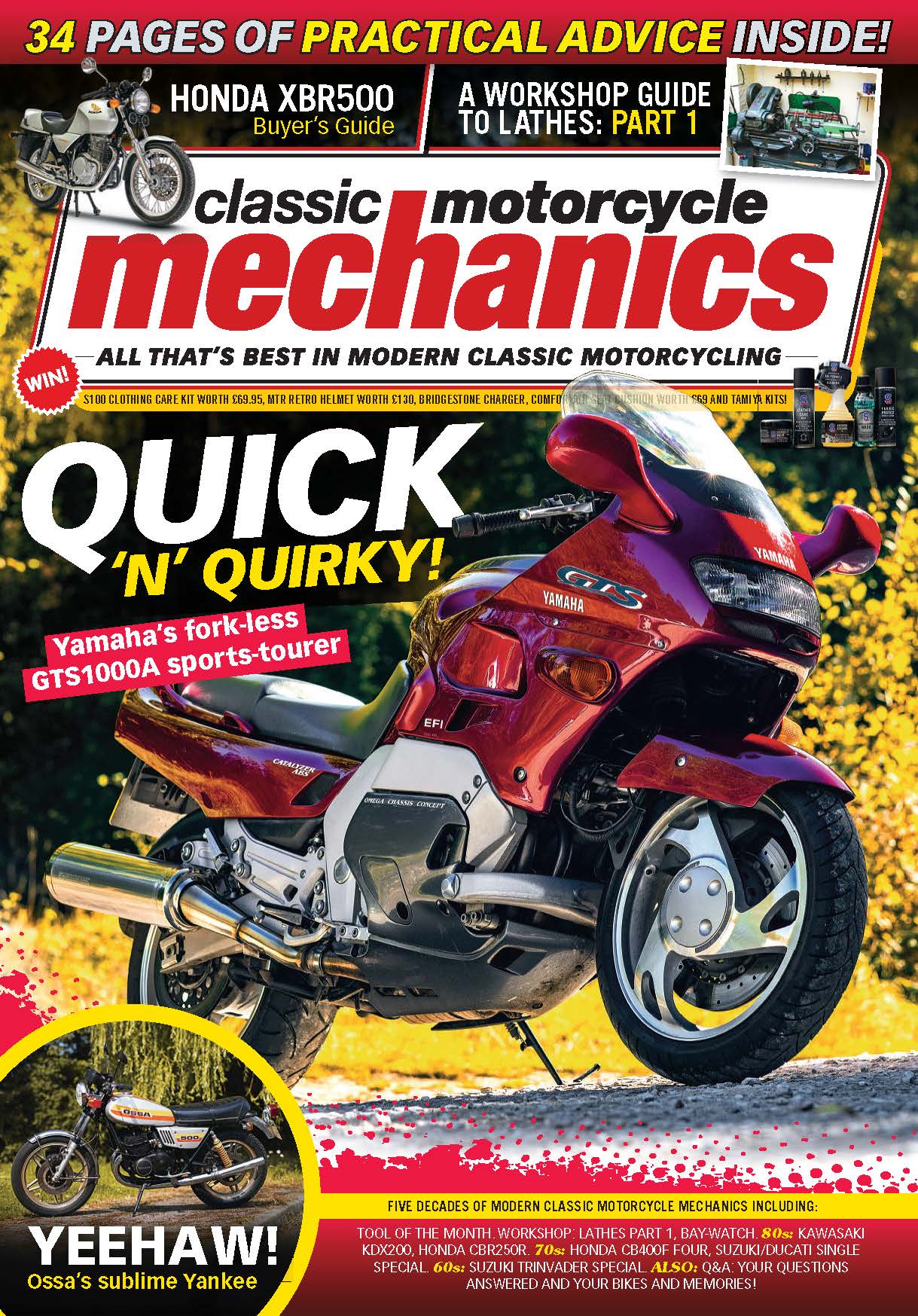Kawasaki’s 350 triples are very possibly the hidden gems of the family, but don’t expect frugality! Steve Cooper rides the S2A.
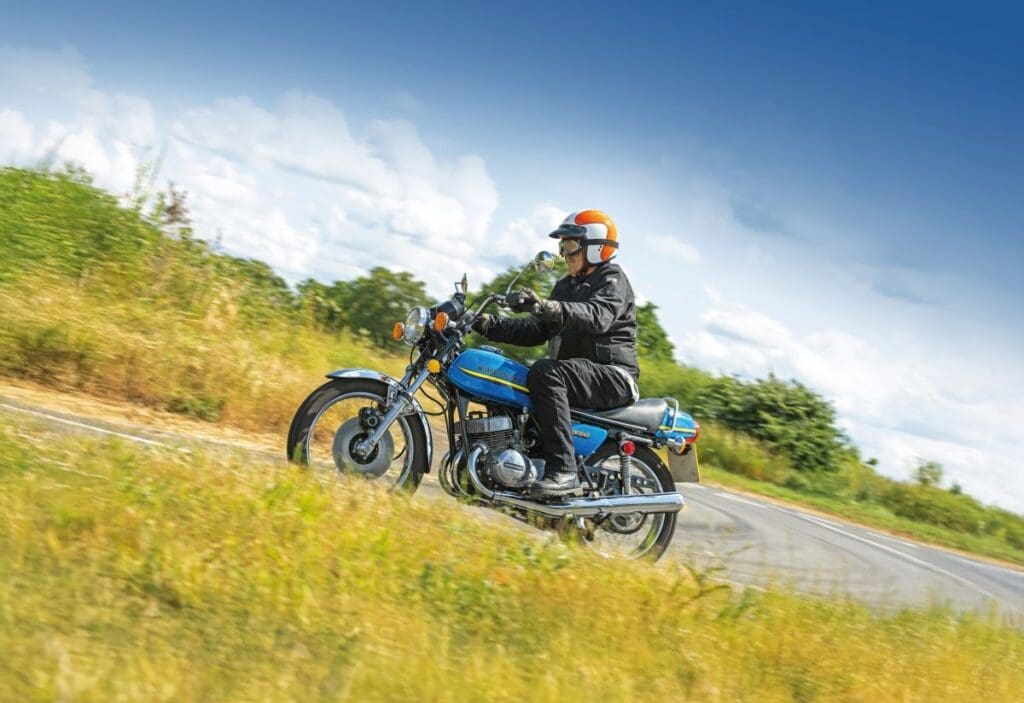
Words by Steve Cooper Photos by Gary Chapman
It’s only taken me 50 or so years finally to sample the delights of Kawasaki’s S2 350. Arguably one of the rarest of the legendary triples and almost unequivocally the thirstiest.
It’s not for nothing that some acolytes of the marque refer the firm’s S2 and S2A as being ‘petrol-cooled’. Back in the early 1970s when Luton bike giants Coburn & Hughes were importing Kawasakis, they had an unofficial competition to see who could get the worst fuel consumption figures.
Apparently the 350 won hands down with results in the low teens! Yet, back then with go-go juice just 34p a gallon (yes, I know, makes you want to weep, etc.) it really wasn’t seen as a major stumbling block to hydrocarbon hedonism.
Our test machine is the 1973 iteration in the guise of the S2A model with the key upgrade of a hydraulic disc front brake. Replacing the S2’s twin leading shoe anchor, this vital change probably stopped a fair few riders from running out of road.
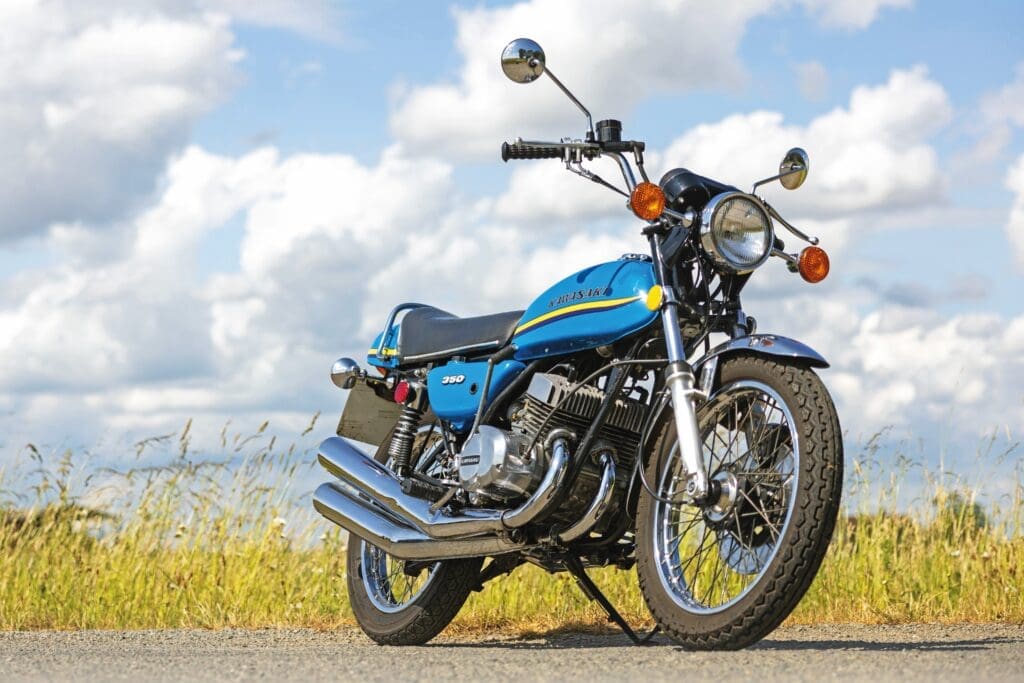
The old TLS unit wasn’t especially bad but given the bike’s performance potential it was doubtless a welcome improvement. Other than the brake, a chromed front guard and new paint/decals, the S2A hadn’t really changed that much and fans of the 350 and would-be owners were undoubtedly very pleased. Why? Because the Kawasaki 350 triple was something of a weapon. Easily capable of whooping Suzuki’s new GT380 or the T350 that came before it, the Kawasaki was also more than up for a fight with Yamaha’s RD350. The 1972 S2 would happily have eaten Yamaha’s older YR5 for breakfast without a second glance and it was probably only the RD’s race-derived frame that allowed the twin to just get the better of the triple. All of which is entirely hypothetical half a century on where few of us ‘kids of the glam rock era’ have anything to prove now.
You’d have to be a fully paid-up, card-carrying, misanthrope to decry the work of Kawasaki’s stylists. The firm might have been last to the party but that didn’t stop them building some stunning looking bikes. Just how good do those twin dark blue and yellow graphics look on the solid pale blue? To add a little more drama there’re thinner versions swooping over the top of that ‘two-years-only’ flat-sided tank. And, obviously, it wouldn’t look right without the iconic tail piece which is similarly bedecked. There’s no rear guard on our test bike as it’s an American market model, but other than that part it’s much the same as sold across Europe. Check out the chainguard – there’s absolutely no reason for it to sport those pressed holes other than looks. And, because we’re looking at a wild child from the early 70s, the S2A has the then almost mandatory steering damper as fitted to most Japanese bikes of the period.
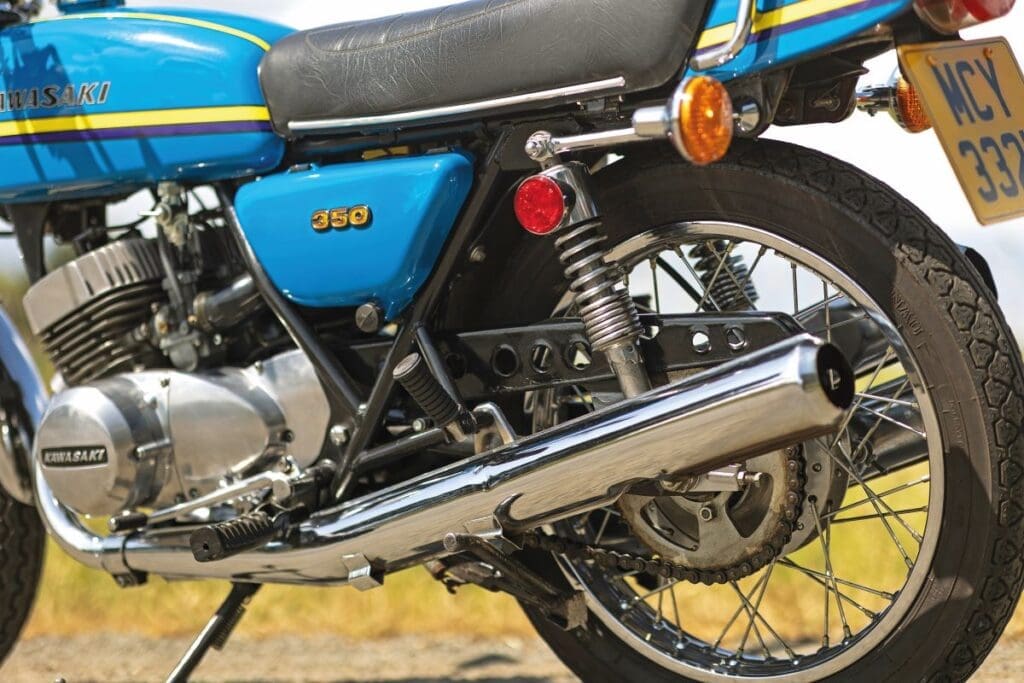
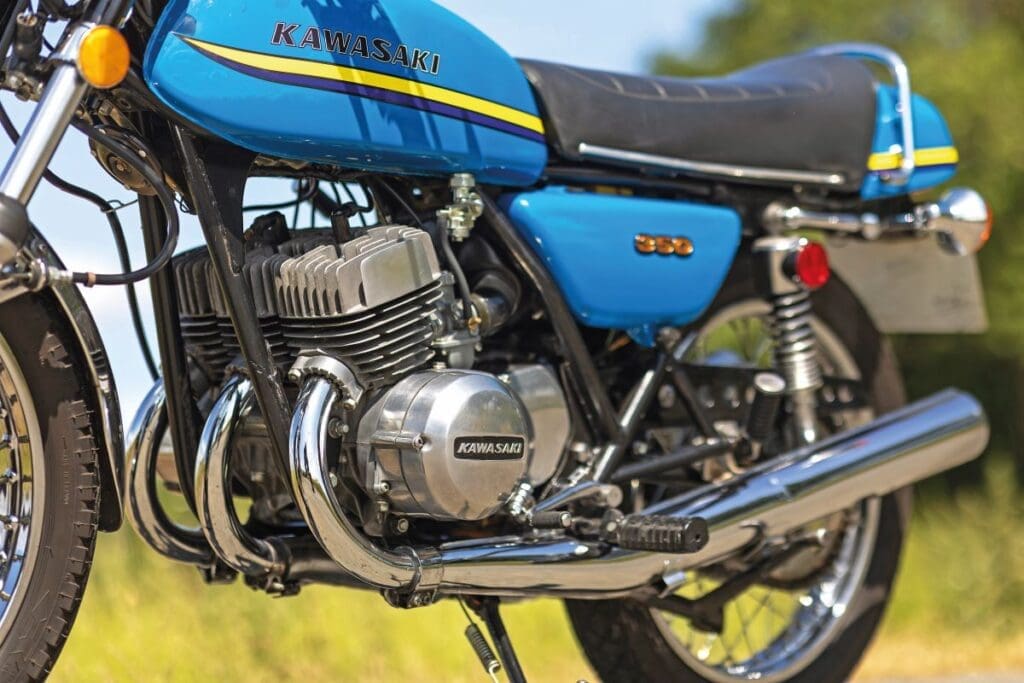

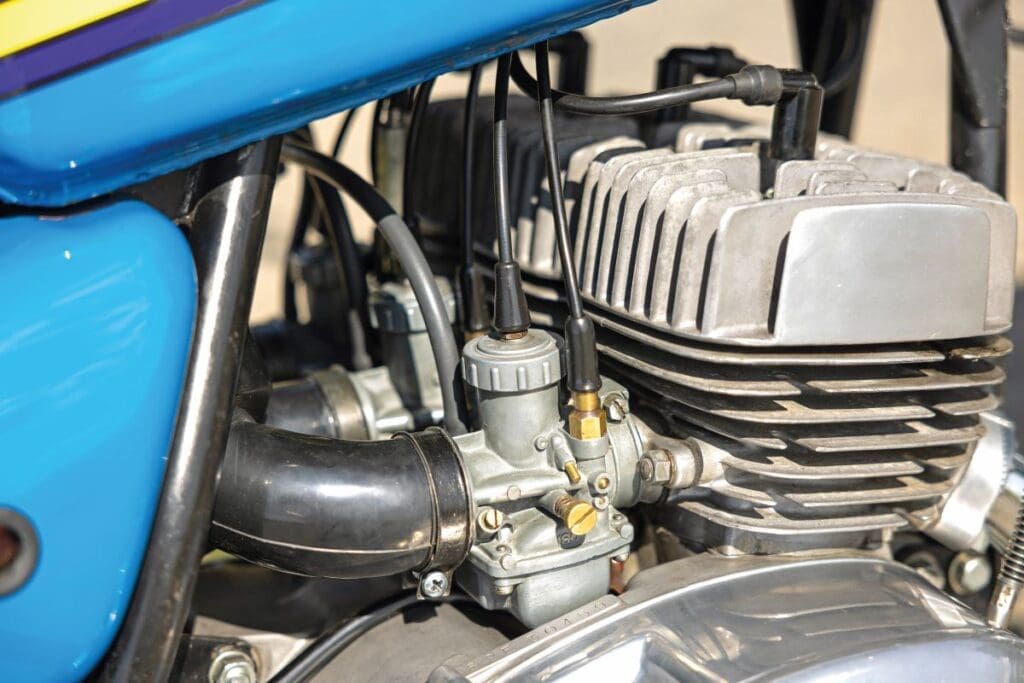
Perceived as a mechanism with which to control so-called ‘tank slappers’, its presence supposedly treated the symptoms instead of the cause. The bigger brothers had the option to add a second hydraulic steering damper to the bottom yoke, and the subsequent S3 was similarly equipped.
The instruments, in a black plastic binnacle, are effectively generic and common across the range of the period other than the red-line. The left instrument cluster houses the lights’ on/off and hi/lo switches together with the indicator switch and horn button. Over on the opposite side there’s just a choke which is spring-loaded and requires the rider to push it down whilst actuating the kick-start lever ready to catch the motor as it fires up. If I’m honest I’m sure you’d get used to it, but it’s really not the most ergonomic of arrangements. If there was a way of actually holding the choke in the ON position like most other bikes of the period life would be much easier.
Once alive, the asymmetric exhaust lets out a unique note that turns into a rasp at the twist of the light throttle. Despite being a Kawasaki triple, the S2A has its own unique sound that subtly distinguishes it from the 250 and 500. Throwing a leg over the seat, the immediate impression is one of dimensions, or rather lack thereof. Just like their rivals, Kawasaki used the same running gear for both 250 and 350 iterations so the plot is on the small side and compact.
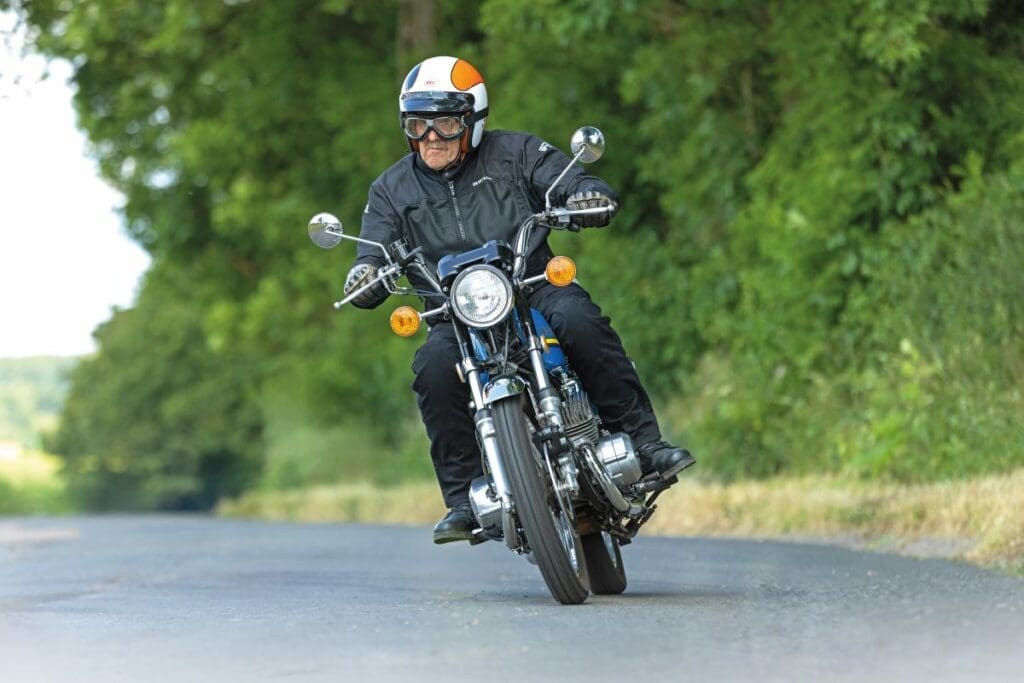
The S2A’s ergonomics are of their time and the USA-spec bars have you sitting close to upright. UK models would have sported lower bars as seen in the late, great John Robinson’s 1971 road test of the previous S2. Getting some weight over the front wheel via lower bars also would have ameliorated the need for the aforementioned steering damper. However, we’re not going to be ragging this bike to the limit and especially so as owner Roger Eastwood is in attendance. At least the high bars take the weight off ageing wrists I suppose.
The bike comes from a period when US law makers were only just getting to grips with automotive environmental legislation and the S2A is probably one of the last triples not to be hobbled. This means that although not unduly noisy, it’s not exactly muted either. The air-box emits a delicious drone as the revs pick up and it’s this soundtrack and not the trio of exhausts that the rider hears. You wouldn’t go out on a limb and state the bike’s designers purposely engaged in acoustic tuning here, but it does sound bloody fantastic: yes, I could get hooked just listening to it.
For a 350 the S2A punches above its weight, delivering a quoted 45 horses just before the orange needle buries itself in the red zone. Now, of course, those ponies are Kawasaki’s interpretation of the dynamometer’s reading and taken at the crank, yet all things are relative. Yamaha were quoting 39bhp for their RD350 while Suzuki were pitching the GT380 at 38. Having sampled all three I’ll happily go on record stating the blue Kawasaki here is definitely the liveliest of the bunch. A combination of more aggressive porting and compression ratios has the S2A at the front of the pack as the most belligerent machine overall, but most emphatically there’s not the same rabid animal tendencies as exhibited by its half-litre uncle of a few years earlier.
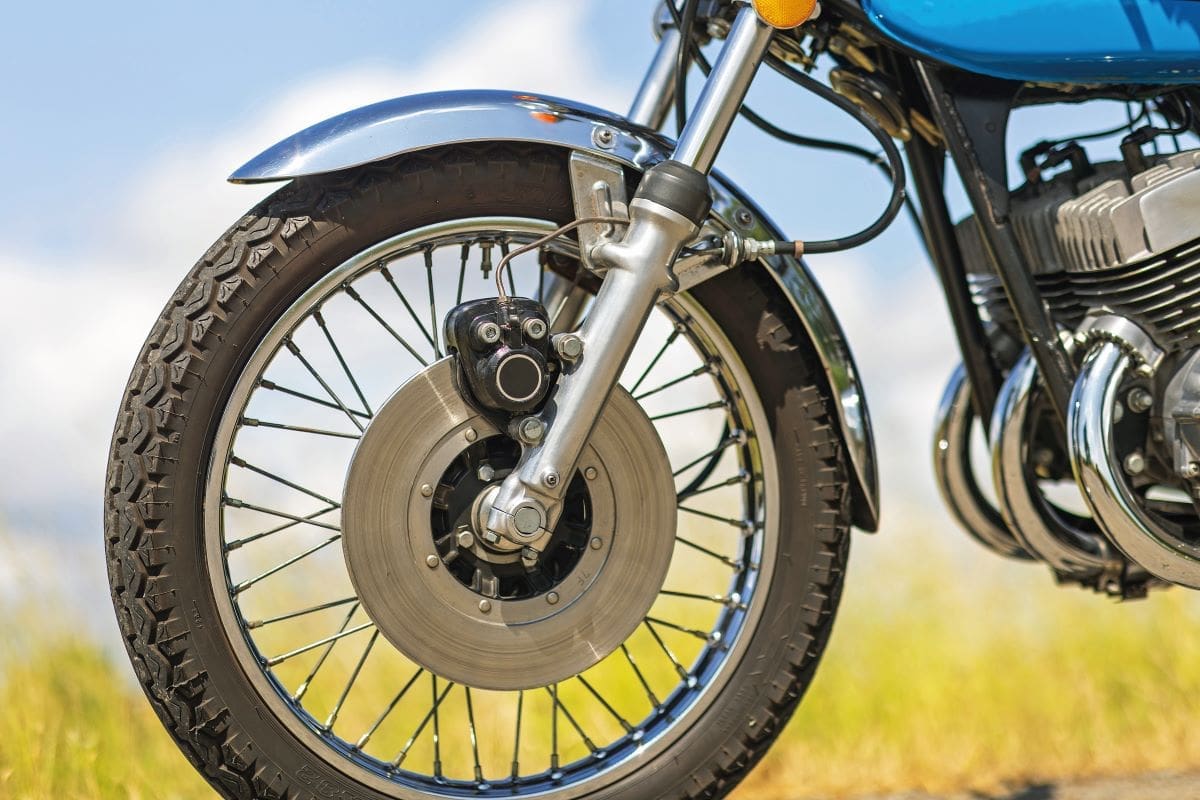
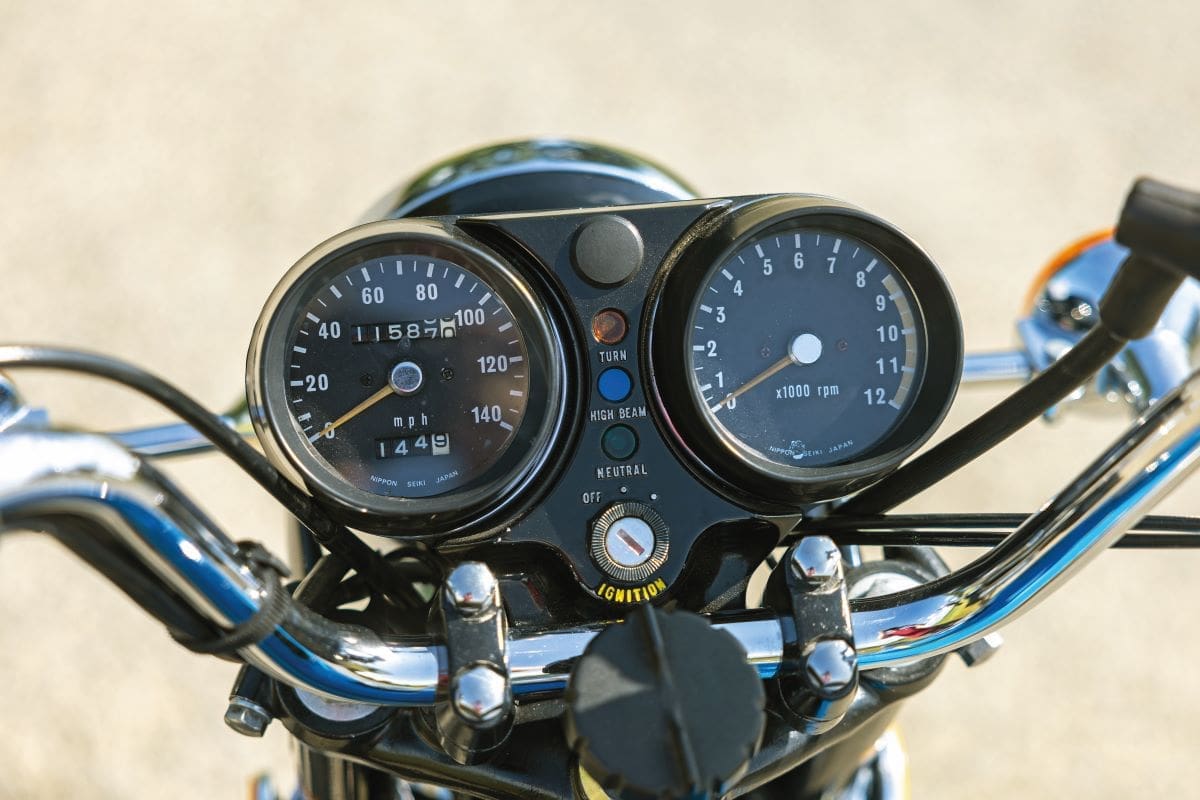
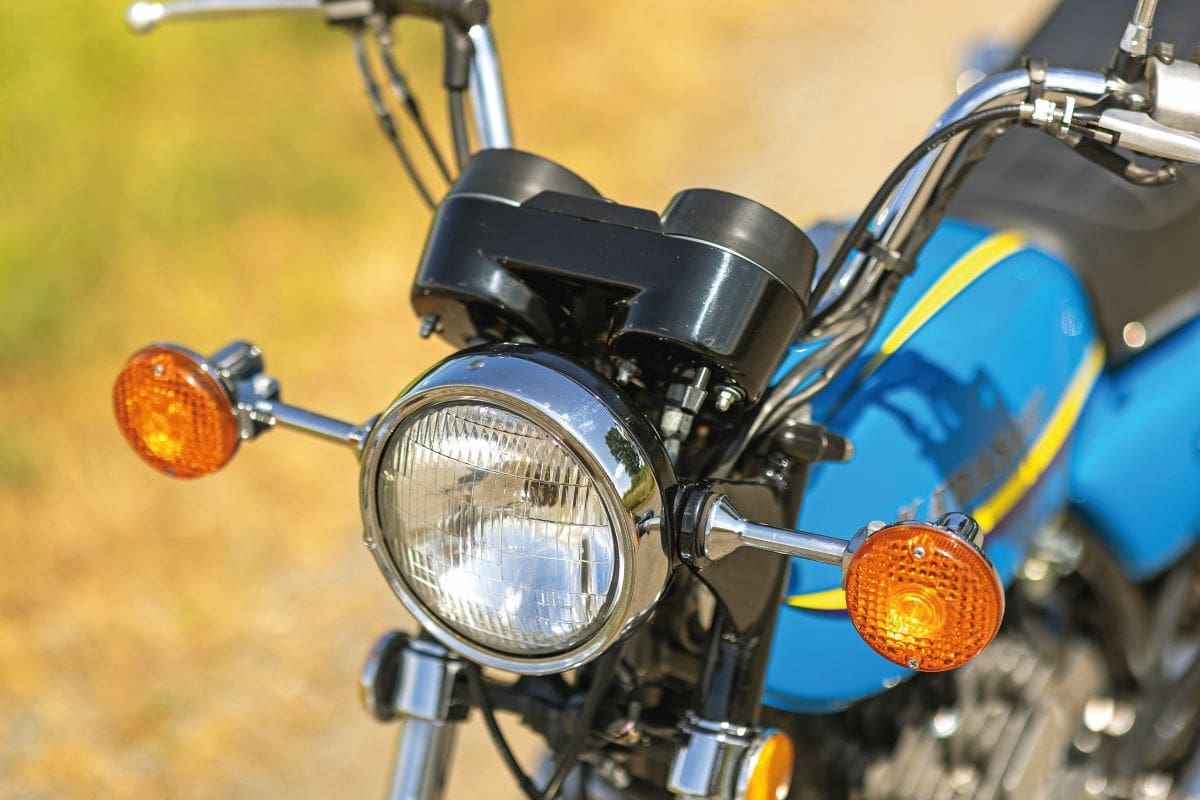
As soon as the tacho hits 5500rpm the S2A fair hurtles away in a most addictive manner. Am I a fan? You betcha! I love the GT380 for its easy-going nature, all-round comfort and exhaust note. And my own RD350 is such a well-rounded bike given its giant killing rep but the Kawasaki… quite simply it’s the Pepperami of the group. Yes, it’s a bit of an animal but not unpleasantly or worryingly so. No wonder the 350s made such animpression on the period journalists of the day.
Theory suggests an inline triple should be super-smooth, but that’s theory for you. As the revs rise and the various period production line tolerances come into play there’s buzzing going on around six grand and again another two grand later. To be honest it all adds to the fun and if it was silky and liquid you’d probably question why all the hype. The gearbox is one down and four up, so much more in line with the custom of the day rather than the bigger triples where neutral sat at the bottom. With the footrests set almost level with the swingarm spindle there’s a need for a set of linkages but, blissfully, there’s no slop or wear, meaning changes aren’t hampered or hindered. The change process possibly feels a little mechanical in action and not as smooth as an RD’s or as liquid as a GT’s, but it’s not an issue, just very subtly different in all honesty.
Which is just as well, as keeping each of those 115.3cc pots on the boil is key to the game. If the tacho is showing noon or later you’re smiling like an idiot and lining up the next bend ready for some more hedonistic, hydrocarbon-fuelled fun.
Nit-picking? There’s not much to moan about once you get used to the quirky choke other than the kick-start lever which tends to rub the back of your calf on occasion – other than that it’s remarkably glitch-free.
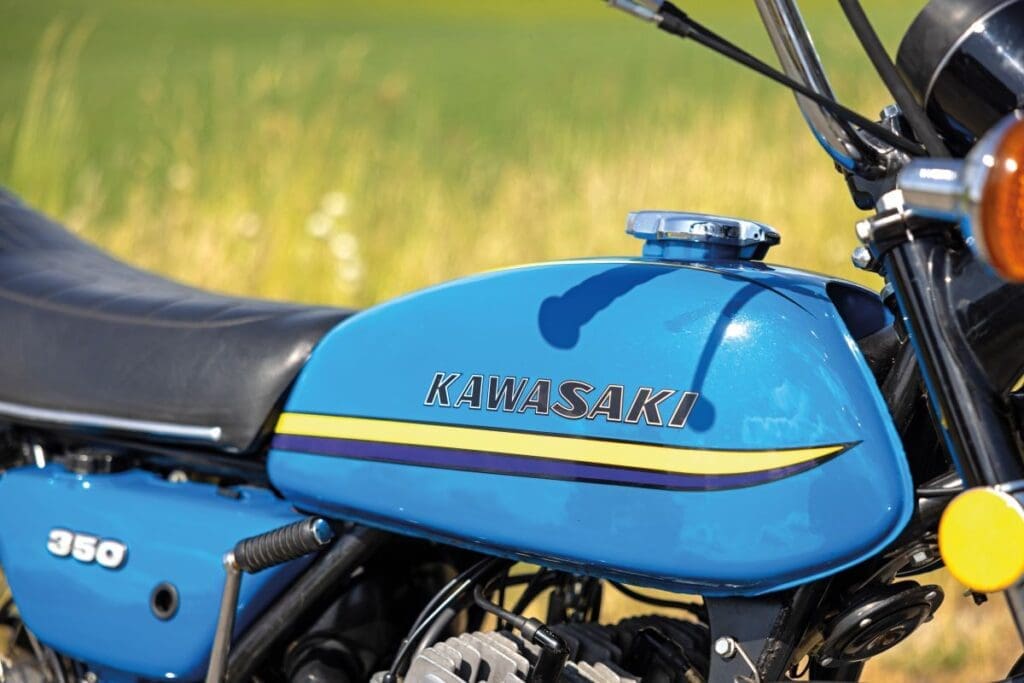
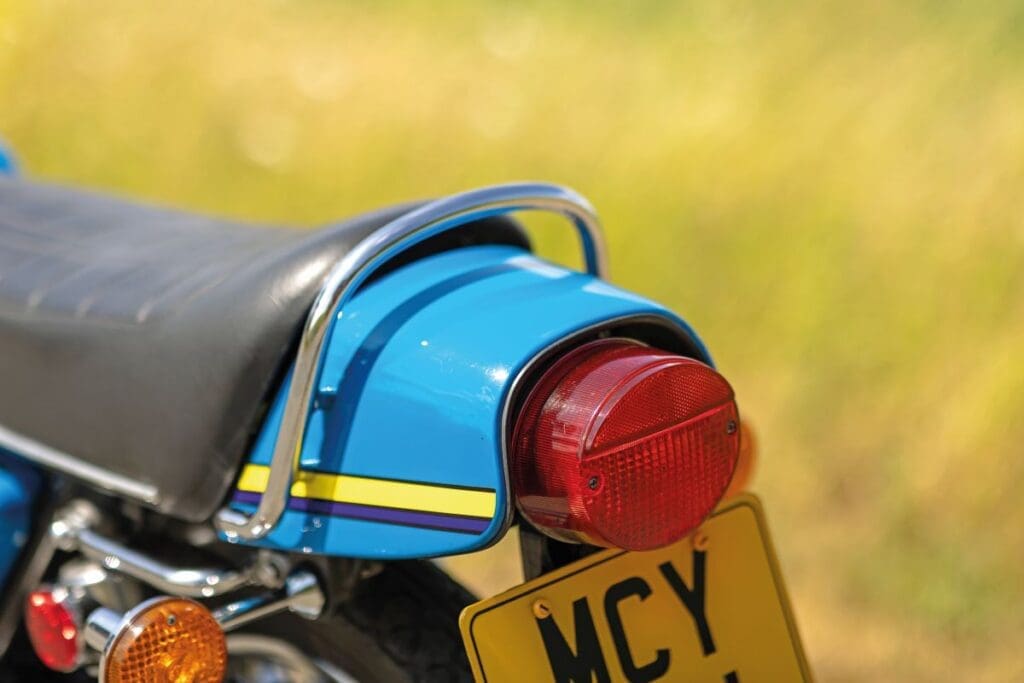
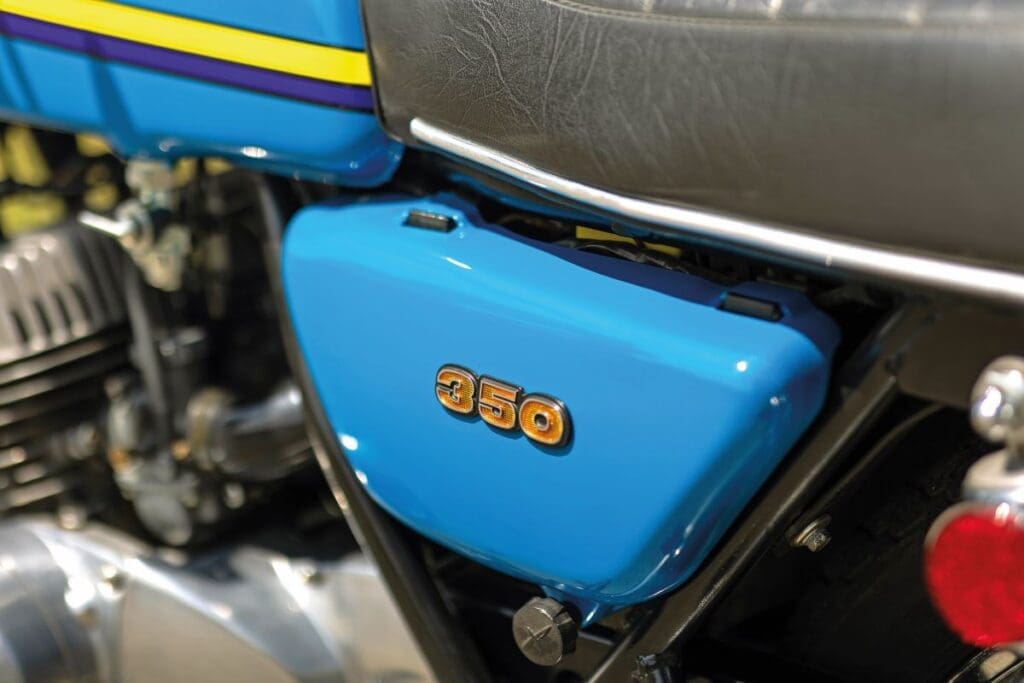
Kawasaki triples aren’t supposed to handle according to the urban myths but here such old wives’ tales are simply hokum. The S2A is no better or worse than its peers and tracks just fine on its period-looking, modern compound, Heidenau rubber. Just like every other bike of the period, the suspension was made down to a price but, within the limits of a classic of the era, it’s absolutely fine. The frames of the 250/350/400 are acknowledged as being the most rigid of the genre and our test bike was absolutely well mannered and predictable.
Given the S2A’s peppy nature and propensity for egging its rider on, it’s a relief to be able to report back that the brakes are definitely above the so-so level. The S2A’s hydraulic front brake addresses the one overriding issue that hamstrung the pervious S2: there’s no brake fade, no incipient panic, and no lever going back to the bar. Having sampled KH400s, I’d have to say the S2A’s caliper does a better job than the later versions by an appreciable amount. The rear brake is cableoperated but has plenty of feel and predictability.
For me at least the last 350 triple from Kawasaki is one of the firm’s best middleweight packages of the period and given the space and cash I’d have one – despite the ravenous thirst for petrol. Sadly, the S2A is neither plentiful nor cheap. Decades ago you might have bought one for peanuts, but not now. Both owners and dealers know just how desirable these bikes are so you could be into £5500-£6250 for something decent with aftermarket spannies on. Add in an original exhaust and you’re into £8000 territory.
Is a 1973 350 stroker actually worth that? Arguably not from a purely pragmatic viewpoint, but that’s until your actually ride one. I’d challenge anyone with a penchant for air-cooled stink wheels who’d sampled an S2 or S2A not to lust after one. If a certain well-known Danish lager company made two-strokes…
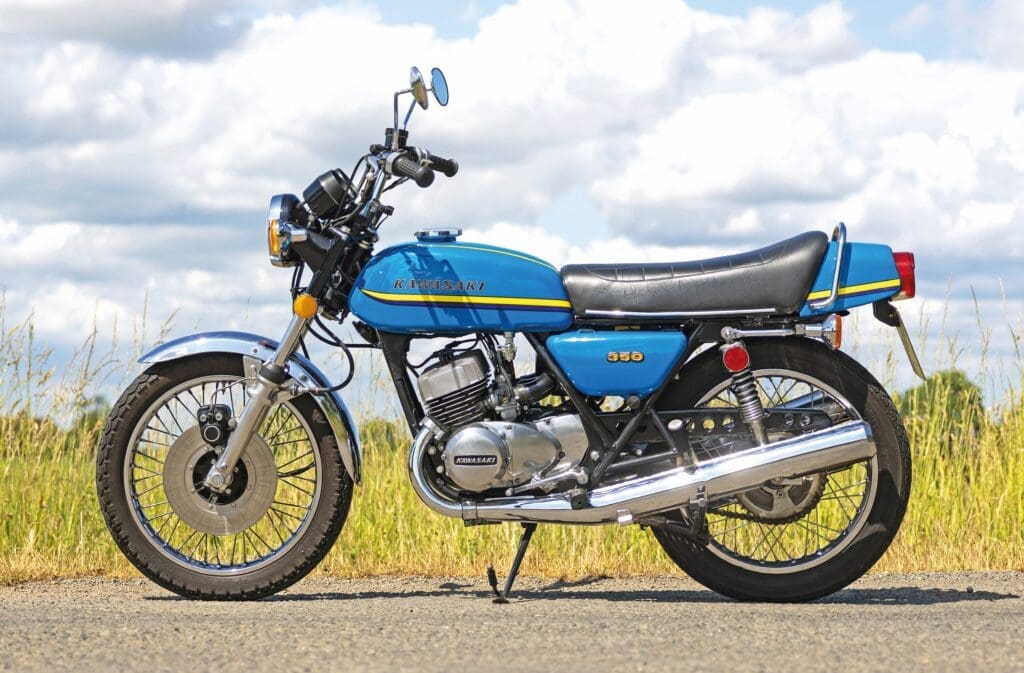
Going from S2 to KH400
The S2 arrived in late 1971, offering the looks and dimensions of the S1 250 but blessed with substantially more power.
Kawasaki optimistically claimed a top speed of 112mph with a quarter-mile in 13.6 seconds – truth-bending at its best quite possibly, but it also grabbed the headlines.
Outwardly very similar to the 250 other than the side-panel badge, the only other giveaway was an extra fin on the cylinders.
1974 saw the engine grow to a nominal 400ccs as the S3 and gained outer cylinder heads with full length outer finning similar to Yamaha RDs of the period. Despite the increase in capacity, the power dropped to 42bhp as Kawasaki began muting performance by way of more conservative porting. 1977 saw the bike rebranded as the KH400 with less power in an attempt to be ever-so-slightly more ‘green’ − if that were ever possible with such a machine.
By 1978 the model had been dropped in the USA and notionally replaced by the likes of the Z400 twin – some chance – or the smaller Z four-cylinder offerings (close but no cigar, etc.). In a few markets the 400 smoker lasted until about 1980 but then the party was over officially for one of Kawasaki’s best two-stroke triples.
Owner’s story – Roger Eastwood

I always felt the Kawasaki two-stroke triples from the 1970s were very attractive machines to look at, so when I found a 1973 350cc S2A that was for sale, I decided to buy it.
The 350 is not a common machine, so I thought I would snap it up while the chance was there. Although all the blue paintwork and the seat were in very good condition, the bike did need quite a bit of tidying up. I did not want the machine off the road for ages whilst undergoing a nut and bolt restoration, I really wanted to ride it.
So, I just concentrated on getting some key parts like the handlebars, grab rail and headlight rim rechromed and some other black parts like the headlight shell, clock housing and chain guard professionally resprayed.
Also I replaced a few other parts like the mirrors and rubber bits and the rest was just elbow grease, polishing up the remaining chrome parts and the engine alloy.
It will never win any shows, but it still looks very good and is much admired by people who had one or similar ‘back in the day’.
The bike is very easy to maintain and generally there is no problem getting parts – they can be NOS, secondhand or even replica if necessary.
Riding it is a delight, since it handles very well and stops well, not the case with all Kawasaki triples!
And, once I had got the ignition timing right, I found it also performed very well, too. I’ve owned it for seven years and I fully intend to keep it for as long as I possibly can as kickstarting it is very easy on the knees, unlike my H2 Mach IV!
ENGINE TYPE
249cc air-cooled, fourstroke, single, 4-valves
BORE AND STROKE
74.0mm x 57.8mm
CLAIMED HORSEPOWER
26bbhp @ 8500rpm
MAXIMUM TORQUE
17lb-ft @ 7000rpm
TRANSMISSION TYPE
5 speed
COMPRESSION RATIO
9.3:1
CARBURETION
30mm Keihin
TYRES
3.00 -18 (F) 4.10 – 8 (R)
FUEL CAPACITY
3.0 gallons (13 litres)
BRAKES
250mm disc (F),
140mm drum(R)
DRY WEIGHT
136kg (300lb)
WET WEIGHT
148kg (326lb)

